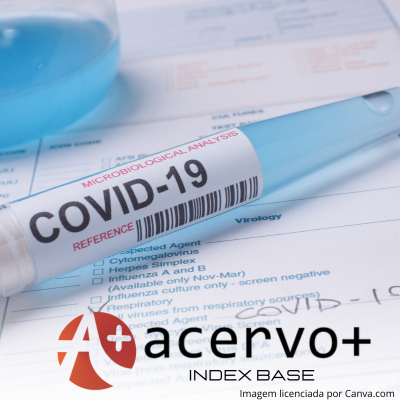Avaliação de desfechos clínicos em pacientes com COVID- 19 com e sem diabetes melitus em um hospital de Teresina – PI
##plugins.themes.bootstrap3.article.main##
Resumo
Objetivo: Analisar o perfil clínico-epidemiológico de pacientes internados com COVID-19 em um hospital de urgência. Métodos: Trata-se de um estudo individuado, observacional, transversal, com amostra de conveniência. Analisou-se à presença de diabetes, mortalidade por faixa etária, necessidade de internação em Unidade de Terapia Intensiva (UTI), mortalidade por tempo de internação na UTI, necessidade de Intubação Orotraqueal (IOT), mortalidade por dias de IOT, necessidade de Drogas Vasoativas (DVA). Resultados: Pacientes diabéticos apresentaram maior taxa de admissão em UTI (76,8%) do que os não diabéticos (NDM) (56%), maior necessidade de IOT (39,5%) em relação aos NDM (33,4%), maior necessidade de DVA (42%) do que os NDM (34,41%). Além disso, pacientes diabéticos apresentaram piores desfechos após admissão na UTI. Verificou-se que a quantidade de glicemias alteradas durante a internação está diretamente relacionada à maior admissão em leitos de UTI, necessidade de IOT e óbito. Conclusão: Conclui-se que a presença de diabetes e o mal controle glicêmico antes e durante internação estão relacionados a piores desfechos.
##plugins.themes.bootstrap3.article.details##
Copyright © | Todos os direitos reservados.
A revista detém os direitos autorais exclusivos de publicação deste artigo nos termos da lei 9610/98.
Reprodução parcial
É livre o uso de partes do texto, figuras e questionário do artigo, sendo obrigatória a citação dos autores e revista.
Reprodução total
É expressamente proibida, devendo ser autorizada pela revista.
Referências
2. ARONS MM, et al. Presympomatic SARS-CoV-2 infections and transmission in a skilled nursing facility. The New England Journal of Medicine, 2020; 382(22): 2081-2090.
3. AZEVEDO MCA, et al. Relação fisiopatológica entre covid e diabetes melitus tipo 2: uma revisão narrativa. Revista Acervo Saúde, 2022; 15(4): 10154.
4. BARROS HM, et al. Perfil epidemiológico e correlação entre comorbidades com o tempo de internação, desfecho e necessidade de ventilação invasiva em indivíduos com COVID-19 em um hospital de referência do estado do Pará, Brasil. Revista eletrônica Acervo Saúde, 2022; 15(8): 10825.
5. CARIOU B, et al. Phenotypic characteristics and prognosis of inpatients with COVID-19 and diabetes: the CORONADO. Study Diabetologia, 2020; 63(8): 1500-1515.
6. CLEMENT S, et al. Management of diabetes and hyperglicemia in hospitals. Diabetes Care, 2004; 27(2): 553-591.
7. GALICIA-GARCIA U, et al. Pathophysiology of type 2 diabetes mellitus. International Journal of Molecular Sciences, 2020; 21(17): 6275.
8. HARTMANN-BOYCE J, et al. Risks of and from sars-cov-2 infection and COVID-19 in people with diabetes: a systematic review of reviews. Diabetes Care. American Diabetes Association, 2021; 44(12): 2790–2811.
9. HUANG C, et al. Clinical features of patients infected with 2019 novel coronavirus in wuhan, china. The Lancet, 2020; 395(10223): 497-506.
10. HUSSAIN A, et al. COVID-19 and diabetes: Knowledge in progress. Diabetes Research and Clinical Practice, 2020; 162: 108142.
11. INZUCCHI SE, et al. 2023. Management of diabetes mellitus in hospitalized patients. Disponível em: https ://www.Up-to-date.Com/contents/management-of-diabetes-mellitus-in-hospitalized-patients. Acessado em 10 de dezembro de 2023.
12. LEE S, et al. Clinical course and molecular viral shedding among asymptomatic and symptomatic patients with SARS-CoV-2 infection in a comunity treatment center in the Republic of Korea. JAMA internal medicine, 2020; 180(11): 1447-1452.
13. MUNIYAPPA R e GUBBI S. COVID-19 pandemic, coronaviruses, and diabetes mellitus. American Journal of Physiology - Endocrinology and Metabolism, 2020; 318(5): 736-741.
14. ORAN DP e TOPOL EJ. The proportion of SARS-CoV-2 infections that are asymptomatic: a systematyc review. Annals of internal medicine, 2021; 174(5): 655-662.
15. REN H, et al. Association of the insulin resistance marker TyG index with the severity and mortality of COVID-19. Cardiovascular diabetology, 2020; 19(1): 58.
16. RICHARDSON S, et al. Presenting Characteristics, Comorbidities, and Outcomes Among 5700 Patients Hospitalized With COVID-19 in the New York City Area. JAMA internal medicine, 2020; 323(20): 2052-2059.
17. TARGHER G, et al. Patients with diabetes are at higher risk for severe illness from COVID-19. Diabetes & metabolismo, 2020; 46(4): 335-337.
18. TURCHIN A, et al. Hypoglicemia and clinical outcomesin patients with diabetes hospitalized in the general ward, 2009; 32(7): 1153-1157.
19. WORLD HEALTH ORGANIZATION. 2020. Director-General's remarks at the media briefing on 2019-nCoV on 11 February 2020. Disponível em: https ://www.who.int/director-general/speeches/detail/who-director-general-s-remarks-at-the-media-briefing-on-2019-ncov-on-11-february-2020. Acessado em 15 de abril de 2024.
20. WU L, et al. COVID-19 and diabetes: Insulin requirements parallel illness severity in critically unwell patients. Clinical endocrinology (Oxford), 2020; 93(4): 390-393.
21. WU Z e MCGOOGAN JM. Characteristics of and important lessons from the coronavirus disease 2019 (COVID-19) outbreak in China: summary of a report of 72 314 cases from the chinese center for disease control and prevention. JAMA internal medicine, 2020; 323(13): 1239-1242.

